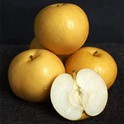Hey there! As a sand pear supplier, I've spent a ton of time thinking about these amazing fruits and their cultural significance. So, let's dive right in and explore what makes sand pears so special.
First off, sand pears have a long - standing history in many cultures. In Asia, especially in China and Japan, they've been around for centuries. They're not just a delicious snack; they're deeply rooted in traditional festivals and ceremonies.
In Chinese culture, pears are often associated with separation. Sounds a bit odd, right? Well, the Chinese word for pear, "li" (in Mandarin), has the same pronunciation as the word for "separation". But don't think that's all negative. There's a kind of bittersweet beauty to it. For example, when friends or family members are about to part ways, they might share a pear. It's a way to acknowledge the sadness of separation while also enjoying the moment together.
Now, in Japanese culture, sand pears have a more positive connotation. They're seen as symbols of longevity and good health. The Japanese have a tradition of giving pears as gifts during the New Year. It's believed that by sharing these fruits, they're sharing the hope for a long and healthy life in the coming year.
Let's talk about the different varieties of sand pears. There are some really cool ones out there. One of them is the Round Sugar Pear. This pear is known for its round shape and super - sweet taste. It's like biting into a little ball of sugar. People love it not only for its flavor but also because it's so visually appealing. It's often used in fruit displays during special occasions.
Another variety is the Lovely Pear. As the name suggests, it's just lovely. It has a smooth texture and a delicate flavor. This pear is great for making desserts. You can poach it, bake it into a pie, or even just serve it with a scoop of ice cream. It's a real crowd - pleaser.
And then there's the Snow Pear. This one is famous for its crispness and juiciness. It's like taking a refreshing bite out of a snowbank. In traditional Chinese medicine, snow pears are used for their cooling properties. They're often made into soups or teas to help soothe a sore throat or reduce internal heat.


Sand pears also play an important role in art and literature. In Chinese paintings, pears are often depicted as part of a still - life scene. Artists use the shape and color of the pears to add a sense of tranquility and beauty to their works. In literature, pears are sometimes used as metaphors. They can represent innocence, purity, or the passing of time.
From a culinary perspective, sand pears are incredibly versatile. You can eat them fresh, right off the tree. Just give them a good wash, and you're in for a treat. Their sweet and juicy flavor is a great way to quench your thirst on a hot day.
If you're feeling a bit more adventurous, you can use sand pears in cooking. They work well in both sweet and savory dishes. For a sweet dish, you can make a pear tart. Just slice up some pears, arrange them on a buttery crust, and bake until golden brown. It's a simple yet delicious dessert.
For a savory option, you can pair sand pears with cheese. The sweetness of the pears balances out the richness of the cheese. A classic combination is sand pears with blue cheese. The sharpness of the blue cheese and the sweetness of the pears create a flavor explosion in your mouth.
In addition to their cultural and culinary significance, sand pears are also good for you. They're rich in vitamins C and K, as well as dietary fiber. Vitamin C is important for boosting your immune system, while vitamin K helps with blood clotting. The fiber in sand pears can aid in digestion and keep your gut healthy.
As a sand pear supplier, I'm really passionate about these fruits. I've seen how they bring people together, whether it's at a family gathering or a cultural festival. I've also witnessed the joy on people's faces when they take their first bite of a fresh, juicy sand pear.
If you're a chef looking to add something new and exciting to your menu, or if you're just someone who loves good food and wants to explore different cultures through cuisine, sand pears are a great choice. They offer a unique combination of flavor, texture, and cultural significance.
I'm always looking for new partners to work with. Whether you're a restaurant owner, a grocery store manager, or just someone interested in buying sand pears in bulk, I'd love to have a chat with you. We can discuss the different varieties, the best ways to store and use the pears, and of course, the pricing.
So, if you're interested in learning more about sand pears or want to start a business relationship, don't hesitate to reach out. Let's work together to bring the wonderful world of sand pears to more people.
References:
- Traditional Chinese Cultural Studies on Fruits
- Japanese Festive Customs and Fruit Symbolism
- Culinary Arts: The Use of Sand Pears in Different Cuisines





